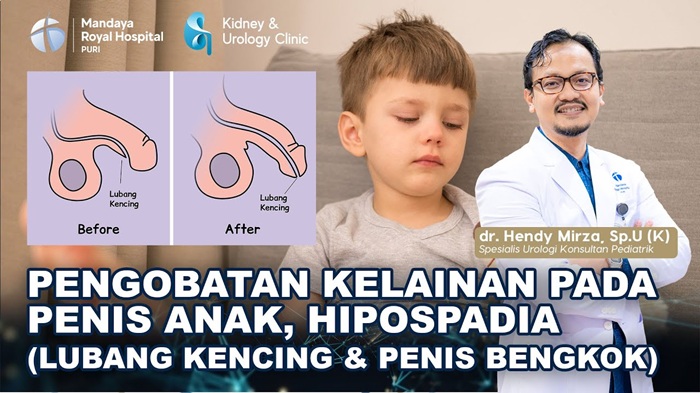Hypospadias is a congenital condition in boys in which the urethral opening is not located at the tip of the penis but on the underside of the penile shaft. This condition is typically detected at birth and may be accompanied by symptoms such as a curved penis, an irregular urine stream, and an abnormal position of the urinary opening. Although it may sound concerning, hypospadias is a condition that can be effectively treated when diagnosed and managed by an experienced specialist.
To ensure children receive comprehensive and complete care, RS Mandaya Royal Puri provides hypospadias management by an experienced pediatric urology consultant, dr. Hendy Mirza, Sp.U (K). He has special expertise in handling hypospadias, from evaluation and surgical planning to reconstructive procedures designed to optimize the function and anatomical appearance of the child’s penis.
Contents
Hypospadias Explained and Its Treatment by dr. Hendy Mirza at RS Mandaya Puri

Hypospadias is a congenital abnormality in boys where the penis does not develop normally from birth. This condition can usually be identified immediately after delivery due to its distinctive appearance. The three primary signs include a urinary opening that is not located at the tip of the penis, a curved penile shaft, and an abnormal shape of the foreskin. Hypospadias occurs in approximately 1 in every 200–400 male births.
According to dr. Hendy, the exact cause of hypospadias remains unknown. However, several risk factors are believed to contribute, such as genetic influences—which account for about 10% of cases—maternal health issues during pregnancy, or exposure to certain medications or environmental substances. Despite these risk factors, hypospadias is not a life-threatening condition and does not require emergency surgery.
When Does Hypospadias Need Surgery?
The ideal time to perform corrective hypospadias surgery is before the child reaches 2 years of age. The goal of surgery is to restore normal penile structure so that urinary and sexual functions in adulthood can develop properly.
There are three main objectives of hypospadias surgery:
- Straightening the curved penis (correcting chordee).
- Relocating the urethral opening to its normal position at the tip of the penis.
- Improving cosmetic appearance, ensuring the penis resembles normal anatomy.
With a straight penis and a correctly positioned urethral opening, children will later be able to urinate normally—including standing up—and achieve normal sexual function as adults.
What Are the Risks If Hypospadias Is Not Corrected?
In mild cases of hypospadias, where the urethral opening is not too far from the tip and there is no significant curvature, the condition may not cause major issues even without surgery.
However, in severe cases—such as when the penis is significantly curved or the opening is located near the base—surgical correction is strongly recommended.
Untreated severe hypospadias may lead to:
- Difficulty urinating normally
- Inability to urinate while standing
- Problems with sexual function later in life
- Difficulty with fertility because sperm may not reach the partner
- Psychological distress due to penile appearance
One-Stage or Two-Stage Surgery
Hypospadias surgery may be performed in one or two stages depending on the severity of penile curvature (chordee).
- If the curvature is less than 30 degrees, a single-stage procedure is usually sufficient.
- If the curvature is severe, a two-stage procedure is required to increase surgical success.
After surgery, most children can return to normal activities within approximately 2–4 weeks.
dr. Hendy Mirza’s Schedule at RS Mandaya Royal Puri

You can meet dr. Hendy Mirza, Sp.U (K) at RS Mandaya Royal Puri during the following schedule:
- Monday: 16.00 – 19.00 WIB
- Wednesday: 16.00 – 19.00 WIB
- Friday: 16.00 – 19.00 WIB
To make your visit easier, use the WhatsApp Chat, Book Appointment feature, or the Care Dokter app—available on Google Play and the App Store—to manage appointments, view queue numbers, and access complete information.



